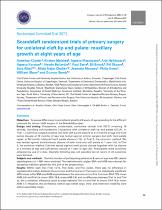Scandcleft randomized trials of primary surgery for unilateral cleft lip and palate: maxillary growth at eight years of age
Abstract
Objectives: To assess differences in craniofacial growth at 8 years of age according to the different
protocols for primary cleft surgery in the Scandcleft project.
Design and setting: Prospective, randomized, controlled clinical trial (RCT) involving 10
centres, including non-syndromic Caucasians with unilateral cleft lip and palate (UCLP). In
Trial 1, a common surgical method (1a) with soft palate closure at 3–4 months of age and hard
palate closure at 12 months of age was tested against similar surgery but with hard palate
repair at 36 months (delayed hard palate closure) (1b). In Trial 2, the common method (2a)
was tested against simultaneous closure of both hard and soft palate at 1 year (2c). In Trial
3, the common method (3a) was tested against hard palate closure together with lip closure
at 3 months of age and soft palate closure at 1 year of age (3d). Participants were randomly
allocated by use of a dice. Operator blinding was not possible but all raters of all outcomes
were blinded.
Subjects and methods: The total number of participating patients at 8 years of age was 429. Lateral
cephalograms (n = 408) were analysed. The cephalometric angles SNA and ANB were chosen for
assessing maxillary growth for this part of the presentation.
Results: Within each trial (Trial 1a/1b, Trial 2a/2c, and Trial 3a/3d), there was no difference in
cephalometric values between the common and the local arm. There were no statistically significant
differences in the SNA and ANB angles between the common arm in Trial 1a (mean SNA 77.8, mean
ANB 2.6) and Trial 2a (mean SNA 79.8, mean ANB 3.6) and no difference between Trial 1a and Trial
3a, but a statistical difference could be seen between Trial 2a and Trial 3a (mean SNA 76.9, mean
ANB 1.7). However, the confidence interval was rather large. Intra- and inter-rater reliability were
within acceptable range.

